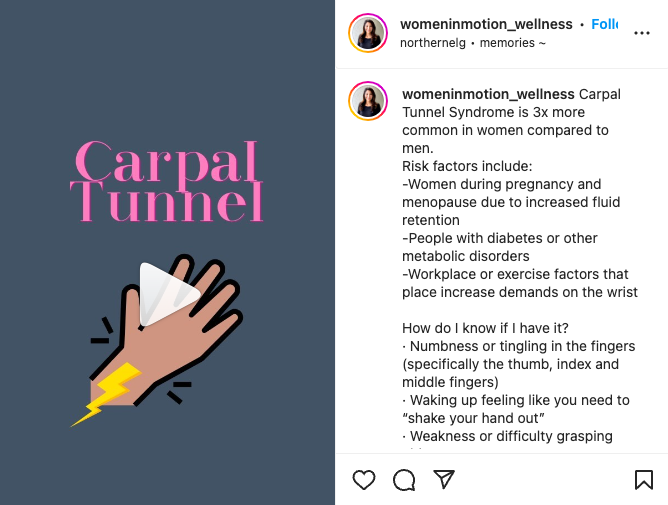Carpal Tunnel Syndrome
What is carpal tunnel syndrome:
Carpal tunnel syndrome is the compression of the median nerve as it goes through the carpal tunnel which is located at the base of our wrist. Women and people with diabetes or metabolic disorders are 3 times more likely to develop carpal tunnel syndrome.
Compression of the nerve can result from:
Repeated postural demands (common in desk workers and exercise or work demands that require prolong positions with weight through the hands or repeated wrist motions)
Repeated use of vibrating tools
Fluid retention common during pregnancy and menopause
Trauma from a wrist fracture or injury
Common Signs and Symptoms:
Numbness or tingling in the fingers (specifically the thumb, index and middle fingers)
Waking up feeling like you need to “shake your hand out”
Weakness or difficulty grasping objects
In chronic cases you may see wasting away of the muscles at the base of the thumb
Treatment:
The majority of people find relief and resolutions of symptoms through conservative measures. These include:
Physical Therapy
Splinting
Activity modification
Medication and injections
If conservative measures fail surgical options may be considered.
For some exercises and stretches to help with carpal tunnel syndrome check out our Video Post
Our Physical Therapy Services:
If you or anyone you know is dealing with carpal tunnel syndrome come see us! Our physical therapist are specialized in orthopedics and can address posture, nerve mobility, tight muscles and hands on treatment and or dry needling to give you lasting symptom relief. We offer in person and virtual consults.
Are you pregnant?
If you are currently pregnant and want to learn more about how to reduce the risk of nerve injuries, orthopedic aches and pains and pelvic floor trauma from pregnancy and delivery check out our class:
Our pregnancy prep course is offered in person and on demand. It is designed for laboring mothers and their birth partners. It has as strong focus on reducing the risk of pelvic floor, orthopedic and nerve birth injuries by:
Teaching women how to relax their pelvic floor muscles for pushing
How to shorten the pushing stage of labor by optimizing babies positioning
How to create more space in the pelvis to promote babies descend
And most importantly how your birth partner can be your continuous labor support to improve your overall birth experience


